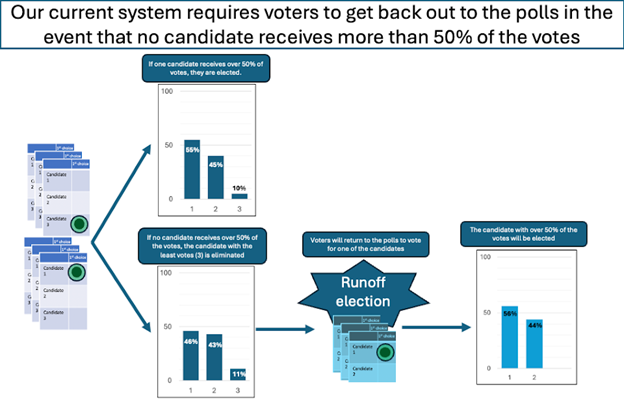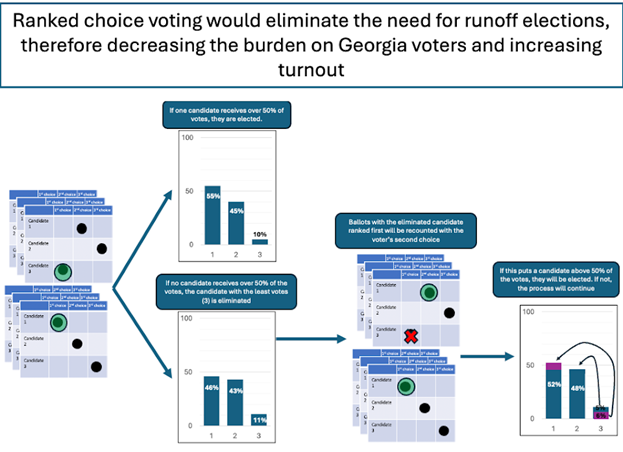By Julia Conzalez Varela Saborio, Ella Rintala, and Patrick Ryan
In Georgia, if no candidate receives over 50% of the votes, a runoff election is required. This system was put in place during the 1960’s explicitly to discriminate against non-white minority group voters. Ranked Choice Voting (RCV) has been proposed as one method to eliminate the need for runoff elections.
As a purple state, Georgia elections receive an inordinate amount of national attention. All eyes are on us. As a state, it is imperative that we make sound and secure voting decisions.
On January 26th 2024, Georgia Senate voted 31 to 19 in favor of SB355 which prohibits ranked-choice voting (RCV). The bill died in the Georgia House. This has left many Georgians wondering – what actually is ranked choice voting?
Herein, we explain the current voting process in Georgia, the basics of ranked choice voting, how RCV addresses some Georgia ballot issues, pros and cons, and what the science says.
Current System
Georgia is one of the only states that still allows a runoff in general elections. Currently, if no candidate in a single winner election receives over 50% of votes, a runoff election is necessary. Voters must return to the polls to cast another vote for their elected officials. This second election, as of 2021, must happen within 4 weeks of the general election.

In most states, during the regular election, the candidate with the most votes wins, even if they do not have over 50% of the votes.
The Georgia law requiring a candidate to win by a majority was made in the 1960s explicitly to discriminate against non-white minority group voters since they cannot achieve a majority. Runoff elections come with high costs, with the 2021 senate runoff election estimated to have cost Georgia around $10 million. In December 2022 Georgia Secretary of State Brad Raffensperger called for reforms to the “majority requirement” process.
Ranked Choice Voting (Often Called, RCV)
Georgia has provided ranked choice voting forms for military personnel in elections that could result in a runoff since 2021.
In ranked choice voting, voters rank candidates from their most favorite to least favorite. In a single-seat election, the candidate with the least votes is eliminated first and that candidate’s ballots are transferred to the voters’ second choice. This process repeats until a candidate wins a majority of votes. This way, if there is not a candidate who wins a majority the first time around, there is no need for voters to go to the polls again to vote in a runoff election.

Pros of RCV
Advocates for RCV argue that it gives voters more opportunity to express their honest opinion and makes their vote more likely to be counted. In addition, it has been proposed that ranked choice voting might eliminate or ameliorate the third- party disruptor effect and increase the election share of third party candidates.
Australia, New Zealand, Malta and Ireland all use RCV, also known as “preferential voting”, “single transferable vote” or STV, and “alternative vote” or AV, in their elections, with Australia having first introduced ranked choice voting over a century ago. Benjamin Reilly, an electoral system design expert at the University of Western Australia, says that he believes RCV has allowed Australia to strengthen the political center and avoid vote-splitting when supporting less-popular candidates.
Cons of RCV
Senator Randy Robertson who sponsored SB 355 claims ranked-choice ballots would confuse voters or leave their vote uncounted if they only chose one candidate and that candidate was eliminated by not being one of the top two final choices. The situation where a voter only chooses one choice, causing their ballot to be discarded, is called “ballot exhaustion,” and led to cases where the winner of an election didn’t actually receive the majority of votes cast.
Mathematicians estimate that 14.5% of the time, a candidate with the highest percent of 1st choice votes would ultimately lose.
What Does the Science Say About RCV?
Information from the United States
Ranked choice voting is currently used by about 50 US counties, cities, or state elections. Some version of ranked choice voting systems have been used in the United States since the early 1900s, but instant-runoff ranked choice, the most prevalent kind of RCV in modern America, is relatively new. Therefore, there is conflicting research on the impacts of instant-runoff ranked choice voting in the US due to a lack of extensive examples. The only information available is for low-information (small sample size) local elections, which means there are a lot of confounding factors that could lead to the results seen. For example, in several California cities, ranked choice voting led to a small increase in women of color running and winning; whereas in San Francisco, RCV has been found to be taken advantage of most by white, affluent voters.
In one of the only studies done in 2020 that researched the large and small-scale effects of RCV, it was found that voters were 5% more likely to vote for an independent candidate on a ranked ballot. This points to ranked choice voting’s potential to decrease polarization between political parties in state representation. But, this study also found that ranked choice elections significantly increased the number of negative advertisements, so ranked choice voting also has the potential to push politicians to greater extremes in order to get ranked above other candidates.
Information from Other Countries
Many countries use RCV and from them there is more research into the effects of RCV, particularly in Australia which has been using ranked choice voting the longest.
An Australian Election Study showed that from 1966 and 2021, there was a drop from 72% to 37%, in individuals always voting for the same party. Between 1986 and 2021, people voting a “split ticket,” where they place a vote for more than one party, has increased from 17% to 33%.
A 2020 study about multiple nations using RCV found that “smaller parties and, in Northern Ireland, moderate parties have increased their representation due to transfers. Additionally, in Ireland and Malta, more women have secured office.” However, gaps between voting model predictions and election results have shown that electoral systems may not have default, proscribed outcomes but more contingent inclinations, thus results may not be the same in the US as there are different socio-political elements and concerns at play.
Find voting resources and information from the Union of Concerned Scientists here.
